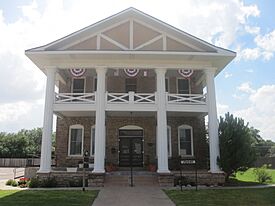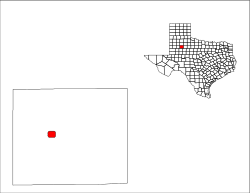Post, Texas facts for kids
Quick facts for kids
Post, Texas
|
|
|---|---|

Garza County Historical Museum in Post is a restored sanitarium
|
|

Location of Post in Garza County, Texas
|
|
| Country | United States |
| State | Texas |
| County | Garza |
| Founded | 1907 |
| Incorporated | 1914 |
| Government | |
| • Type | Council-Manager |
| Area | |
| • Total | 3.774 sq mi (9.775 km2) |
| • Land | 3.745 sq mi (9.699 km2) |
| • Water | 0.029 sq mi (0.075 km2) |
| Elevation | 2,605 ft (794 m) |
| Population
(2020)
|
|
| • Total | 4,790 |
| • Estimate
(2023)
|
3,486 |
| • Density | 931.0/sq mi (359.4/km2) |
| Time zone | UTC–6 (Central (CST)) |
| • Summer (DST) | UTC–5 (CDT) |
| ZIP Code |
79356
|
| Area code(s) | 806 |
| FIPS code | 48-59012 |
| GNIS feature ID | 1365627 |
| Sales tax | 8.25% |
Post is a city in Texas, United States. It is the main city, or county seat, of Garza County. In 2020, about 4,790 people lived there. A type of ancient reptile, the Postosuchus, is named after the city.
Contents
History of Post, Texas
Post is located on the edge of the Llano Estacado. This area is the southeastern part of the Great Plains. The city sits where U.S. Routes 84 and 380 meet.
How Post City Started
The land where Post is now was once part of the U Lazy S Ranch. In 1906, Charles William (C. W.) Post bought the land. He was famous for making breakfast cereals. In 1907, he started "Post City" as a special new community.
C. W. Post wanted to create a perfect town. He bought 200,000 acres of ranchland. He created the Double U Company to build the town. The company built nice houses and other buildings. These included the Algerita Hotel, a cotton gin, and a textile factory. They planted trees on every street. They also did not allow alcoholic drinks.
The Double U Company rented and sold farms and homes to people who moved there. A post office opened in a tent in 1907. It was officially named Post on July 18, 1907.
Growth and Development
Two years later, Post had a school, a bank, and a newspaper. The newspaper was called the Post City Post. Today, the local paper is the Post Dispatch. The railroad reached the town in 1910.
In 1914, the town changed its name to "Post" when it became an official city. This was the same year C. W. Post passed away. By then, Post had 1,000 people. It also had 10 stores, a dentist, a doctor, and a sanitarium. There were also Baptist, Methodist, and Presbyterian churches.
From 1910 to 1913, C. W. Post tried to make it rain. He used explosives in the air at certain times. But records showed that these efforts did not work.
Local Industries and Economy
In 1916, the C. W. Post estate offered $75,000. The town raised $35,000 to try to get a new college built there. But they were not successful.
Postex Cotton Mills started making products in 1913. It had 250 employees. In 1945, the Post family sold the business. By then, the factory made six million yards of cloth each year. It had 375 workers who made Postex cotton sheets and Garza pillow cases. The mill later closed down.
Companies that help with oil fields have been important to Post's economy. Farming and ranching are also very important. In 1989, Post had two libraries, a hospital, and a nursing home. It also had an airport and 90 businesses.
The population of Post has changed over the years. It reached 3,400 people in 1928. It went down to 2,000 in 1940. Then it grew to 3,100 in the 1950s. When the local oil industry grew, the town's population reached its highest point of 4,800 in 1964.
Historical Places in Post
The old sanitarium in Post is now the Garza County Historical Museum. It is located near the courthouse.
Many ranchers and community leaders live in Garza County. One of them was Giles McCrary. He was a former mayor. Until he passed away in 2011, he ran the OS Museum. This museum showed items from both the American West and Asia.
Geography and Climate
Post is located on rolling plains. It is at the base of the Llano Estacado. The city has a total area of about 3.8 square miles (9.8 square kilometers). Most of this area is land. Only a small part is water.
Local Climate
Post has a semiarid climate. This means it is usually dry, but not a desert.
Major Roads and Highways
Population of Post
| Historical population | |||
|---|---|---|---|
| Census | Pop. | %± | |
| 1920 | 1,436 | — | |
| 1930 | 1,668 | 16.2% | |
| 1940 | 2,046 | 22.7% | |
| 1950 | 3,141 | 53.5% | |
| 1960 | 4,663 | 48.5% | |
| 1970 | 3,854 | −17.3% | |
| 1980 | 3,961 | 2.8% | |
| 1990 | 3,768 | −4.9% | |
| 2000 | 3,708 | −1.6% | |
| 2010 | 5,376 | 45.0% | |
| 2020 | 4,790 | −10.9% | |
| 2023 (est.) | 3,486 | −35.2% | |
| U.S. Decennial Census Texas Almanac: 1850-2000 2020 Census |
|||
Who Lives in Post?
As of the 2020 census, there were 4,790 people living in Post. There were 1,188 households and 787 families.
The people living in Post come from different backgrounds:
- About 28.9% were White (not Hispanic).
- About 4.8% were Black or African American (not Hispanic).
- About 0.5% were Native American or Alaska Native (not Hispanic).
- About 0.5% were Asian (not Hispanic).
- About 1.5% were from two or more races (not Hispanic).
- About 63.6% of the population was Hispanic or Latino.
Education in Post
The Post Independent School District serves the city of Post. Students in high school attend Post High School. Their sports teams are called the Antelopes.
Gallery
-
C.W. Post statue in front of the Garza County Courthouse
-
First United Methodist Church at 216 West Tenth Street
-
First Baptist Church at 402 West Main Street observed its centennial in 2008.
See also
 In Spanish: Post (Texas) para niños
In Spanish: Post (Texas) para niños
















